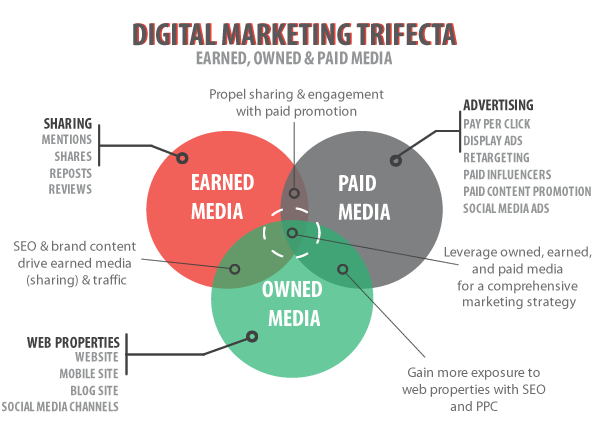I’ve heard the adage about all press being good press being twisted around to “no press is good press,” “even bad press is good press,” and my personal favorite, “press is press.” No matter how you slice it, media attention does command a certain measure of power. It drives attention, gets people talking, and often compels people to act. Whether they act positively or negatively, and whether their actions translate into buying behaviors is another issue.
Our next question to tackle is whether all media is equal. Generally, we can divide media into three separate buckets: earned, paid, and owned.
What is earned media?
Earned media refers to any publicity you receive through promotional efforts. This could be people sharing your social media posts and website, as well as posting reviews about your products and services. Earned media can also be newspaper articles, blog posts, magazine mentions, or content that refers to or features your startup. Somewhat like online word of mouth, earned media strengthens your brand recognition and exposes your product to a customer base that you may not already be reaching.
What is paid media?
Paid media comes through advertising buys and content promotion on social media. Paid media can be accrued both digitally and in print, depending on where you make your buys. If you choose to promote a tweet on Twitter, or sponsor a post on Facebook, you’ll increase your paid media any time someone clicks on your ads and is driven back to your e-commerce channels. Buying an ad in a magazine, newspaper, TV ads, display ads, or a promotional spot also generates paid media. Paid media promotes your content to gain exposure and to ultimately drive either foot or digital traffic towards the places people can buy your product.
What is owned media?
Lastly, owned media refers to any digital property that you own, such as your website and your social media pages. In general, owned media is any communication channel or platform that belongs to you and that you have proprietary control over. Any brick-and-mortar stores, apps, blogs, and social media channels that you own are considered to be owned media.
What type of media is best?
Earned, paid, and owned media can be thought of as a tripod or a tricycle; the three different types work in tandem and support each other. For example, when you gain earned media, it often refers people back to your website, generating owned media. Determining what type of media is “best” for you hinges on what goals you want the media to accomplish.
Do you want to drive foot traffic to your store? Taking out an ad in your local newspaper or a TV spot on a local station can generate the paid media that you need. Are you interested in upping your SEO and website views? Owned media in conjunction with earned media from other sites with good SEO may suit your needs.
Earned media is great because, theoretically, you don’t have to pay for it. Any time people talk about and share your brand, product or services with others in their own social circles or to a larger audience, you essentially get free publicity. They may be influenced to share your startup based on paid media that they might have seen, such as a sponsored Instagram post or a TV spot, but the earned media that they generate is not something that you paid for directly.
Your customers are also likely to consider earned media to be more trustworthy than paid content. Nielsen, in their Global Trust in Advertising study finds that 92% of people completely or somewhat trust recommendations from people that they know, and that 66% trust consumer reviews and opinions posted online. In fact, people trust product and brand recommendations from their friends 7x more than traditional advertising.
Earned media can also increase positive sentiment around your brand. People enjoy hearing positive recommendations from other people whose views they trust. Positive word of mouth generated from earned media drives traffic to your paid media channels, such as a store and website. Ultimately, the overarching goal of most startup endeavors is to generate profit and increase sales. Both print and digital media can address those goals by reaching wider audiences. and by increasing your brand’s presence of mind.
Identifying key media players
Identifying the gatekeepers to earned media, the influencers and voices that will share your brand to others, is the first step in the process. Identification will likely take a tiered approach, where you will begin with influencers at the local level where your brand is located. If your startup is based in Chicago, Chicago influencers and people in the media should be your first place to look when you’re beginning the process of earning media.
National and international media have wider audiences, but there are also significantly higher barriers to entry and increased competition for earned media spots. As you accomplish your goals for earned media at the local level, consider scaling up your PR and moving towards the national level. You should certainly identify key national media partners that you’re interested in the early stages though, but be aware that the bulk of your relationship cultivations should focus on the local level at first.
Doing your research will help you to identify which influencers and media platforms are the right fit. It’s always a good bet to check out sites and print sources that are dedicated to small businesses, entrepreneurship, and startups as they likely already share the type of content that you would want your brand to be included in. Within those sources, identify a few journalists or influencers whose style aligns with your brand. Consider your brand reputation and the type of audience that you’d like to reach when you’re identifying potential new contacts. An edgy young writer on a niche site is going to be less likely to help you reach a conservative older consumer base, for example.
Building up a contact base
It’s always a good idea to start with contacts that you already have something in common with or know. Do you know a journalist in your area? What about someone who has a significant social media influence? Those people can help you to reach larger audiences and generate earned media through relationships that you’ve already built before this process even began.
Networking can be a great way to meet contacts in the media and to build relationships with them. Attend local events where media is present, involve yourself in professional groups and circles, and frequent other startups’ events. Familiarizing yourself with media that covers startups, such as small business journals or blogs, is a good way to become familiar with the types of sites and influencers you may want to pitch your brand to down the line.
You can contact relevant journalists and media persons through social media and LinkedIn by inviting them to connect. You can also often find their email addresses through their platforms, whether that is their media employer or their personal websites and social media. Cold outreach may seem forced, but it can work.

Pitch your startup to influencers
Generating media coverage takes more than sending out a few tweets and hoping that they go viral. Unless the right people are viewing your content, it will fall on deaf ears. In respect to pitching your brand, content, or products, this means that your pitch needs to be directed to the right person. Having done the research to identify the best influencer for your needs, you can frame your pitch to appeal to that person’s media audience.
Your pitch should be tailored to reflect the overall voice of the platform, whether that is a website, newspaper, trade magazine, or social media channel. The content that you pitch, whether it is about a new innovation your startup has made, a new product that will hit shelves soon, or an influencer event that you will be holding, needs to be well crafted and clearly aligned with the type of content that source is already using.
Building and maintaining relationships with the media
A good relationship with the media is not purely transactional; it’s one that you maintain over time and put energy into cultivating. The relationship should benefit both parties and meet common goals, such as page views. Media influencers are often inundated with requests from startups and small businesses who are looking to have their brands be featured as a way to generate their own earned media. Distinguish yourself from the others by positioning yourself as a resource.
Make yourself a resource for stories other than ones that focus directly on your startup. If a journalist reaches out to you for a quote about the startup environment in your city, take advantage of it. Even when the piece is not solely focused on your startup, your name still gets out there and with hyperlinks, you can generate positive SEO credit for your paid media.
How to measure media
Now that you’ve worked to earn your brand media, it’s time to measure the effect it has had. Paid media, especially digital, is a bit easier to track. Since many social media platforms use a pay per click model, you will know exactly how many people saw your ad and came to your website or ecommerce platform as a result. Using the internal analytics that Facebook, LinkedIn, Pinterest, and Twitter provide will also provide you with the quantitative data you can use to benchmark your success during media campaigns. There are also third-party analytics that you can look into, many of which will interpret the data for you, which is a good option if you don’t currently have the capacity to dedicate to benchmarking media.
Measuring print media is less tangible, since newspapers and magazines don’t have analytics built into them that you can use to see how many potential customers were impacted by your advertising. You may choose to measure the success of your print advertising through increased foot traffic to your stores, increased page views for your owned media, or increased sales.
Data for owned media is fairly easy to analyze. Using your website’s backend analytics, you can measure your user engagement over time, and social media channels have their own analytics platforms to do the same. Measuring earned media will depend on your goals. The success of earned media may not be immediately traceable because you don’t own the platform where that media was earned. You may want to benchmark your earned media success through share of voice. Imagine a pie of all of the media that your competitors have. Share of voice refers to the size of your slice in relation to the entire pie. Earned media can increase your slice of the pie, meaning that your brand has more recognition and collateral over time.
Earning media takes time, but the payoffs can be significant. Your public relations, marketing, and advertising strategies should work to increase your earned, paid, and owned media as a complementary process. Avoid getting hung up on the white whale of going viral. While viral digital media is entrancing, it happens only for a lucky few. A slow and steady approach to gaining and cultivating relationships with the media is a tried and true strategy that is more conducive to the long term health of your media presence than viral content in the short term.











